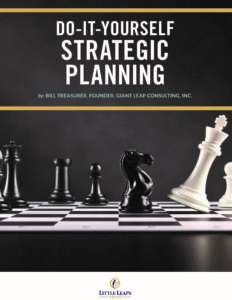To communicate company goals internally and externally, your business must have a strategic plan. But why?
Say your 2020 objective is to increase revenue by 20%, but you don’t tell anyone. How can you reasonably expect to achieve that goal? Don’t carry the burden of a secret expectation and then get mad at everyone else for missing the mark. You need to communicate this objective and find a team of people who are inspired to tie up their laces, show up with their game face, and stick to the plan.
Strategic planning requires getting everyone aligned around clear goals and expectations so they can advance the overall mission of the organization. As a leader, it’s your job to introduce these four key questions and get the stakeholders involved in the answers:
- Where are we today?
- Where do we want to be tomorrow?
- How will we close the gap?
- What will we do to monitor our progress?
Sounds easy enough, right? Just four little questions and then the year is all planned out and that 20% increase is all but guaranteed.
Wrong.

A good strategic plan takes time, collaboration, lots of effort, and plenty of compromises. As a courageous leader, this is what you signed up for—hard work and the willingness to dig deep, make tough decisions, and take risks along the way.
Once the plan is set, it also falls on you to put the plan into action. If your goals leave people feeling uninspired, stressed out, or over-worked, then they will lack the motivation to complete them.
Goals that motivate have common characteristics worthy of consideration as you plan ahead:
- Clarity. Specific, Measurable, Actionable, Realistic, and Time-bound (SMART). When a goal is clear and specific, people know what needs to be done and what is expected.
- Challenge. We are motivated by achievement, so we’ll judge a goal by how difficult we perceive it to be. If it is too easy, we won’t give it as much attention and energy. However, if it demands us to stretch ourselves to achieve the recognition of a job well done, we are more likely to be motivated to excel.
- Commitment. For goal-setting to be effective, the goals must be agreed upon and understood. While this doesn’t mean you negotiate with every employee, there is value in engaging the people working toward those goals.
- Complexity. For highly-complex goals, provide people sufficient time to learn the skills to be successful.
- Feedback. Incorporating feedback into the goal-setting process allows for expectation clarification, necessary adjustment, and personal recognition. In particular, when a goal is long-term in nature, it’s important to set benchmarks that help people gauge their success and see their achievement.
Now you can get to work on that plan!
Once the goals are defined, you need to determine objectives and ways to measure them. Otherwise, you did a lot of work for no reason. The true purpose of creating a strategic plan, communicating your goals, involving your people, setting objectives, and measuring them, is so that in the end, you will have RESULTS. Hopefully, they will amount to the tangibles you set out to achieve.
A strategic plan only happens with exceptional communication and clear goal-setting. Challenging your leadership skills with activities like this is how you grow into your position and how you help your organization grow.
If creating and implementing a strategic plan is brand new to you and your team OR you’re searching for a way to change up how your company has been going about it, reach for my book, Do-It-Yourself Strategic Planning. In it, I provide a proven framework to help leaders build on their operational and tactical knowledge to think more strategically.




